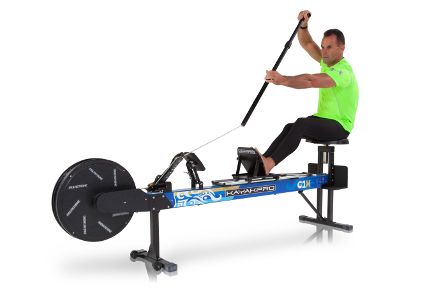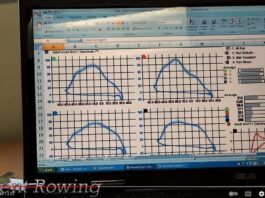The Ergo (or Erg)
- A piece of machinery that attempts to mimic the forces of paddling.
- Used by many clubs in the northern hemisphere for training when the weather is less than friendly (e.g. lakes frozen over)
- Used by some coaches as ONE of the tools to monitor a paddler’s progress, differentiate between paddlers and for crew selection.
There are conflicting opinions on whether ergos are valid for training and testing dragon boat paddlers.
This post will outline what an ergo can and cannot do for you as a dragon boat paddler.
It is very important to get the following sentence down so that we can dissect it and measure the ergo off against each component part.
Dragon boating is a team water sport, where an athlete on a bench seat uses a paddle to propel the boat forward using a technique that the coach is promoting.
Water Sport
Most ergos (Concept and Kayak Pro) use wind resistance to try and mimic the forces a paddle experiences passing through water.
They do not do this very well because with an ergo, the resistance will come onto the handle as soon as the rope tension is taken up which can be on the catch or drive (no matter how high in the air the handle is).
This is unlike reality where the load comes onto the blade when the paddle is in the water and being drawn back. This discrepancy can be minimised with appropriate coaching.
In a dragon boat, it is possible to over power and cause the paddle to “slip” through the water. No such slippage occurs on an ergo – if you pull hard the force is translated directly into the machine and recorded.
Bench seat
The bench seats in a dragon boat are at different heights, with different leg angles and different distances to the foot chocks.
The Concept ergo allows you to change the distance to the foot chocks but not so much the other two variables.
The Kayak Pro is much better at allowing you to adjust the seat position height and foot chock distance to more closely reflect reality.
The Paddle
The ergos are effectively a paddle without a blade. A rope connects the base of the shaft to the ergo mechanism.
At least for some of the stroke the water offers an upward force against the downward force of your paddle. With a dragon boat paddle, the catch should be at an angle (usually positive). This means that a component of your force goes to pushing down (lifting you) and another component goes to pulling back (propelling the boat forward). On an ergo, only the pull back force is measured – all the way through the stroke.
With a dragon boat paddle the blade needs to be kept square to the hull through the drive. On an ergo there is no blade so the force will read the same whether the handle (and therefore the “blade”) is square or not. This discrepancy can be minimised with appropriate coaching.
Propelling the Boat Forward
Paddling a dragon boat propels the boat forward in water which brings a whole bunch of hydrodynamic and aerodynamic forces into play. Forces which, in turn, feedback through to the paddler. An ergo, on the other hand, produces aerodynamic forces through the fan which can be adjusted to approach the hydrodynamic forces experienced in a dragon boat. The ergo does not experience aerodynamic forces similar to a boat and crew pushing through the air/wind, which means neither does the ergo paddler.
And here is the KICKER!!
The most significant difference between the ergo and paddling is that, in a dragon boat, the paddle is planted in the water and the body and boat moves toward the paddle. In exercise terminology this is called a closed chain exercise, much like a pull up.
On the ergo the paddle will be pulled back to the body, an open chain exercise, much like a lat pull down. Though visually these exercises look very similar the recruitment pattern of the muscles are actually opposites.
Compare the pull up and the lat pull down….how many people who cannot do a pull up are quite comfortable to do a lat pull down and can even pull down more than their body weight? Despite this they still remain incapable of pulling up!!
The ergo has that exact same problem with transfer-ability. So in short, however “good” you get on the ergo, this will have no direct translation to how fast you are on the water other than from a fitness and base technique perspective.
Technique
It is a common understanding that the ergo machine loves a long, long stroke – so long that for some paddlers, the paddle can be almost horizontal at the back of the stroke. There are many worldwide ergo competitions where this technique is prevalent. Whilst this is great for getting big scores on the machine, it doesn’t encourage a proper dragon boat technique. This practice can removed through proper coaching and supervision.
https://youtu.be/THJ7LG36fYY?t=20s
The advantage of an ergo is that it allows a technique coach to comfortably walk around the paddler and get a 360 degree view of their stroke. Adjustments can be easily made and verbal feedback provided. This full 360 degree view is a little harder to achieve in a dragon boat without cameras, etc.
Summary
So, weighing up all of the above, the question becomes “Is an ergo valid for training and testing dragon boat paddlers?”
For me, the answer is “Yes but …”
Why?
Ergos are:
- Relatively cheap
- Can process a lot of paddlers in a short amount of time.
- Can be used when the weather is against you or you are too far away from water
- Good for coaches to get a close up view of your stroke from all angles.
- Good at providing data that can be analysed to produce stroke length, power outputs, power to weight, etc.
- Used for excellent anaerobic and aerobic work outs.
- Good for coaches to see your “intestinal fortitude”- how far YOU are willing to push yourself.
- Good for coaches to see how you perform, from a fitness perspective, over a full race distance. Do you start off like a train and die off at the end or do you paddle consistently throughout the run.
- Good for providing a common platform for comparing one paddler to another on SOME criteria. On water testing is the ideal but also introduces many more variables (wind, current, tide, eddies, water depth changes, etc.)
- Good at producing data that is no less valuable for crew selection or paddler comparison than other metrics that are gathered by coaches (beep test level, push ups, chin ups, kettle bell reps, bench presses, etc.)
A Big But:
- Ergos are an open chain exercise machine and dragon boat paddling is a closed chain exercise. This video explains this.
Knowing the limitations of the ergo, I would still recommend one for the reasons above but at the end of the day, it is not a silver bullet for training a dragon boat paddler. It is part of a suite of tools that a coach can use.












Hello~
I am a member of Korea dragon boat team, Ares.
We want to buy a machine.
Is it possible to buy it?
If so, how much is it?
Hi Joongkeun Choi. Two brands you may wish to research are the MultiStroke by KayakPro and the Concept 2 Indoor Rower (with a paddle adaptor).